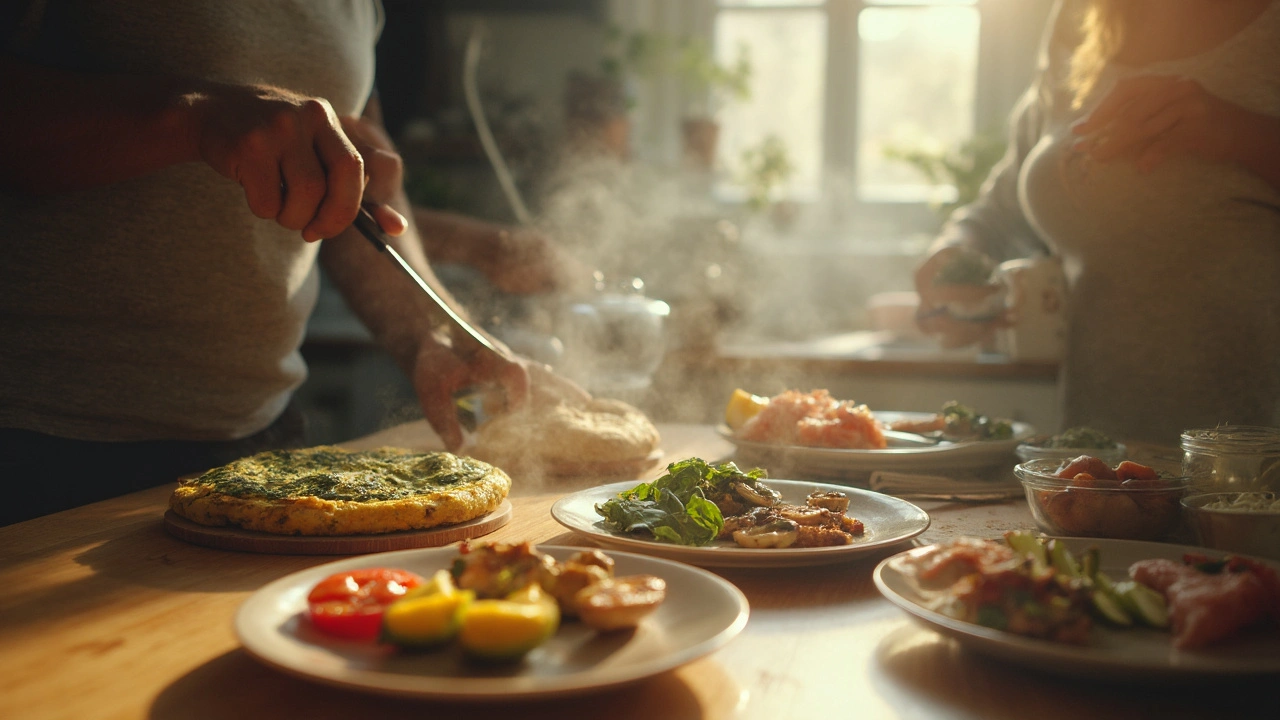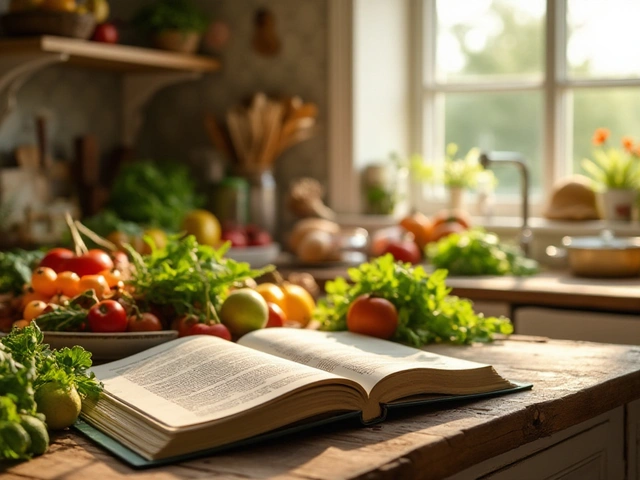Most breakfasts are sneaky dessert in disguise. Granola that looks saintly? Often more sugar than cake. The fix is not to eat less breakfast, but to eat a smarter one that actually keeps you full. Weight loss still comes from a calorie deficit, but the right morning meal makes the rest of the day easier: steadier energy, fewer snack attacks, and less mindless grazing.
- Hit a simple target: 20-30 g protein + 8-10 g fiber + mostly whole-food carbs + some healthy fat, in roughly 300-450 kcal (women) or 400-600 kcal (men), depending on your needs.
- Protein and fiber control hunger signals and cravings (Leidy et al., Am J Clin Nutr, 2013; Slavin, Nutrients, 2013).
- Build low energy density: lots of fruit/veg and fluid-rich foods for volume without many calories (Rolls, Physiol Behav, 2005).
- Watch the add-ons: granola, nut butters, juices, and coffee creamers can double calories fast.
- Keep 3 go-to options you can make in 10 minutes or prep in batches, so busy mornings do not derail you.
The Breakfast Fat-Loss Playbook (What Works and Why)
I live in Adelaide, and winter mornings here can be chilly. That is when a warm, protein-rich breakfast stops me reaching for a muffin at 10 a.m. This is the core method I use with clients and at my own table.
1) Set your protein anchor. Aim for 20-30 g at breakfast. That level helps satiety and preserves lean mass during weight loss. In meal terms: 200 g high-protein Greek yogurt, 2 eggs plus 120 g cottage cheese, 150 g firm tofu, or a scoop of quality whey/soy isolate. A practical cue: 0.25-0.3 g per kg body weight at breakfast covers most adults (Moore et al., J Nutr, 2015).
2) Add real fiber. Hit 8-10 g at breakfast from oats, chia, psyllium, berries, pears, or wholegrain toast. Fiber swells, slows digestion, and blunts sugar spikes. Soluble types (oats, barley, psyllium, chia) are especially filling.
3) Choose carbs that work with you. You do not need low-carb to lose fat. You need smart carbs as part of your calorie budget. Go for fruit, oats, Weet-Bix, wholegrain toast, quinoa, or leftover brown rice. If you train in the morning, lean a little higher on carbs. If you sit most of the morning, keep them steady and load up on veg volume.
4) Include fat, but measure it. Fat helps flavor and satisfaction, yet it is energy-dense. Use 1-2 teaspoons of olive oil or nut butter, a light sprinkle of nuts, or some avocado. More is not automatically better.
5) Make it big, not heavy. A bowl piled high with berries, yogurt, and chia feels generous but stays light in calories. Think of it as volume without the blowout.
6) Caffeine and hydration. Black coffee or tea is fine. Milk is fine too; just count it. A glass of water and a decent breakfast often quiets snacky cravings that are really thirst.
7) Calories still count. Most adults aiming to lose weight do well with a breakfast in the 300-450 kcal range if eating 3 meals a day. If you prefer two meals, bump breakfast up and keep lunch lighter. If you skip breakfast and feel good, that can also work. There is no one rule; appetite control is the rule.
Evidence snapshot: Higher-protein breakfasts reduce later-day cravings and late-night snacking (Leidy et al., 2013). Fiber improves satiety and supports weight control (Slavin, 2013). Lower energy density meals let you eat satisfying portions for fewer calories (Rolls, 2005). The Australian Dietary Guidelines (NHMRC) back whole grains, fruit, vegetables, and dairy/alternatives as a foundation.
Use this one-line builder: protein anchor + fiber booster + smart carb + measured fat + produce. That is it. Paste that onto your fridge and you are covered.
Grab-and-Go Ideas and 10-Minute Recipes
Here are quick builds I reach for on busy mornings. Macros are approximate. Adjust to your calorie needs.
- Berry chia protein oats: 40 g rolled oats cooked with water or milk, stir in 150 g high-protein Greek yogurt, 1 tablespoon chia, 100 g frozen berries, cinnamon. About 380 kcal, 28 g protein, 11 g fiber.
- Egg and cottage cheese wrap: 2 eggs scrambled with spinach, 120 g low-fat cottage cheese, wrap in a wholegrain tortilla with tomato. About 430 kcal, 35 g protein, 8 g fiber.
- Tofu scramble on toast: 150 g firm tofu crumbled with turmeric, mushrooms, capsicum; 1 slice seeded sourdough; 1 teaspoon olive oil. About 400 kcal, 27 g protein, 9 g fiber.
- Yogurt bowl with nuts and kiwi: 200 g high-protein Greek yogurt, 1 kiwi, 1 cup strawberries, 10 g chopped almonds, 1 teaspoon honey if needed. About 350 kcal, 30 g protein, 7 g fiber.
- Smoked salmon rice cakes: 2 brown rice cakes, 80 g smoked salmon, cottage cheese or light cream cheese, cucumber ribbons, lemon. About 320 kcal, 24 g protein, 4 g fiber.
- Chia pudding, lighter: 2 tablespoons chia soaked overnight in 200 ml unsweetened soy milk; top with 100 g berries and 1 scoop protein powder stirred in. About 360 kcal, 28 g protein, 13 g fiber.
- High-protein smoothie (not a sugar bomb): 1 scoop whey or soy isolate, 150 g Greek yogurt or 120 g silken tofu, 100 g frozen berries, big handful spinach, water or ice, 1 teaspoon flaxseed. About 330 kcal, 35 g protein, 8 g fiber.
- Savory oats with egg: 40 g oats cooked with extra water and grated zucchini; top with 1 poached egg and 20 g parmesan, pepper. About 340 kcal, 22 g protein, 8 g fiber.
- Weet-Bix power bowl: 2 Weet-Bix, 200 g high-protein yogurt, 1 small banana sliced, sprinkle of cinnamon and psyllium (1 teaspoon). About 380 kcal, 32 g protein, 11 g fiber.
- Ricotta and berries on toast: 2 thin slices wholegrain bread, 80 g light ricotta, 1 cup mixed berries, drizzle of vanilla. About 360 kcal, 22 g protein, 9 g fiber.
- Leftover rice breakfast bowl: 100 g cooked brown rice warmed; add 120 g edamame, cucumber, cherry tomatoes, 1 boiled egg, splash of soy-lime. About 450 kcal, 28 g protein, 9 g fiber.
- Miso breakfast soup: 2 cups light miso broth, 120 g tofu, wakame, mushrooms, spring onion; side of 1 slice wholegrain toast. About 320 kcal, 24 g protein, 5 g fiber.
Sweet tooth fix without the crash: Skyr or high-protein yogurt layered with pears and a small square of grated dark chocolate. The protein keeps it steady; the chocolate makes it fun.
Short on time? Do this: Greek yogurt cup + apple + small handful of high-fiber cereal on top. Done in 60 seconds with 25-30 g protein and 8-10 g fiber if you pick a cereal like All-Bran or a bran flake blend.
Budget-friendly swap outs (Adelaide shoppers, this is easy at Coles, Woolies, or Aldi): use frozen berries over fresh when prices spike; choose home-brand rolled oats; pick cottage cheese or eggs as your protein anchor; buy tofu in bulk packs. Flavor comes from spices, citrus zest, and herbs, not pricey toppings.
Plant-based paths: Soy or pea protein, tofu, edamame, tempeh, and higher-protein yogurts made from soy are your best friends. Oat milk tastes great but is mostly carbs; if you use it, add a protein source elsewhere.
I would be remiss not to mention coffee. A flat white with full-cream milk and sugar can rival a small snack in energy. That is fine if you count it. If you prefer to eat breakfast calories, switch to a piccolo, long black, or use less milk/syrup.

Prep, Portions, and Pitfalls: Make It Work on Busy Weeks
Weight loss happens when habits repeat. A tiny bit of planning beats willpower every time. Here is how to set up your mornings so you are not negotiating with your hunger at 7:30 a.m.
Sunday 20-minute prep (or any day):
- Cook a base: a pot of oats, a tray of roasted veg, or a pot of barley/quinoa. Portion into 3-4 containers.
- Protein ready: boil 6-8 eggs, bake a block of tofu, or grab tubs of high-protein yogurt or cottage cheese.
- Fruit and veg: wash berries, slice cucumbers and capsicum, bag leafy greens. Frozen is fine too.
- Flavor kit: portion nuts and seeds (10 g packs), small jars of pesto or salsa, lemon wedges.
- Build-and-go stacks: group ingredients on one fridge shelf so you can grab without thinking.
Portion cues you can use without a scale:
- Protein: palm-sized serving, about 20-30 g protein.
- Carbs: a cupped hand of oats, cooked rice, or cereal; 1 slice of dense wholegrain bread.
- Fat: one thumb of nut butter or oil; a small sprinkle of nuts.
- Fiber boosters: 1 tablespoon chia or 1 teaspoon psyllium if your fruit and grains are light.
Calorie ranges that keep breakfast satisfying for weight loss:
- Smaller framed or sedentary: 300-350 kcal (1250-1450 kJ)
- Average active: 350-450 kcal (1450-1880 kJ)
- Taller/very active or two-meal days: 450-600 kcal (1880-2510 kJ)
Common breakfast traps (and easy fixes):
- Granola mountains: measure 30 g, not a free pour; better yet, sprinkle granola on yogurt instead of making it the base.
- Avo toast blowouts: half an avocado is lovely but heavy. Use 1/4 avocado and add protein (egg or cottage cheese).
- Hero smoothies that hide dessert: keep fruit to 1-1.5 cups, add a real protein source, and skip juice. Water or milk is enough.
- Acai bowls: treat them like dessert unless you intentionally portion the base and add protein powder or yogurt.
- Juice: it is fruit without fiber. Eat the fruit, drink water.
- Coffee creamers and syrups: track them like you would track a snack.
Make it crave-proof:
- Protein first bite: Start with a forkful of eggs or a spoon of yogurt before the fruit/toast. It blunts the sweet rush.
- Slow down: Take 10 minutes to eat, not 3. Satiety signals are slow. A short pause often stops seconds.
- Front-load fiber: Add chia, psyllium, or berries if you are hungry before lunch.
Quick decision tree if you wake up starving vs not hungry:
- Starving: choose 30 g protein + 10 g fiber + higher volume (e.g., big yogurt bowl with chia and berries). Eat now.
- Not hungry: have coffee/tea and water; pack a portable breakfast to eat when hunger hits mid-morning so you do not raid the biscuit tin.
Travel routine (work trips, school runs, airport mornings):
- At home: pack protein powder sachet, a shaker, and a small bag of bran flakes or oats. Any cafe can sell you milk or a banana.
- On the road: order eggs on toast with extra tomatoes/spinach, hold the butter, and ask for sauce on the side.
- Hotel buffets: fill half the plate with fruit and veg, add eggs or yogurt, then a slice of toast. Skip the pastry mountain unless it is something you truly love, then portion it and savor it.
Seasonal swaps in Australia right now: late winter mandarins and pears are great fiber bombs; new-season strawberries are arriving; oats and barley are perfect for warm, filling bowls on cold mornings.
Mini-FAQ and Next Steps
healthy breakfast ideas that actually help with weight loss are not magic. They are simple patterns you repeat. Here are answers to what you are likely wondering next, plus quick fixes if you are stuck.
FAQ
- Can I skip breakfast and still lose weight? Yes. If skipping feels natural and you do not overeat later, it can work. If you get hangry and raid the pantry at 11 a.m., a protein-rich breakfast will probably serve you better.
- How many carbs should I eat in the morning? It depends on your activity. If you train early, you may feel better with 40-60 g carbs. Desk morning? 25-40 g is plenty for most.
- Are eggs OK if I have high cholesterol? For most people, eggs are fine within a balanced diet. If you have familial hypercholesterolemia or specific advice from your doctor, follow that first. Pair eggs with veg and whole grains, not bacon and buttered croissants.
- Are meal replacement shakes useful? They can be a tool on chaotic mornings. Look for 20-30 g protein, at least 5 g fiber, and under 10 g added sugar per serve. Keep whole-food breakfasts as your default.
- Is cereal ever OK? Yes, if you pick a high-fiber option (at least 8 g per 100 g) and add protein like Greek yogurt or a protein shake on the side.
- Do I need supplements? Not for breakfast specifically. If you avoid dairy, ensure you get calcium and iodine elsewhere. A basic vitamin D check is reasonable if you do not get much sun in winter.
Troubleshooting by scenario
- Always hungry before lunch: Increase protein to 30-35 g and fiber to 12 g. Add volume (berries, cooked veg) without piling on fat.
- Cravings by 3 p.m.: Push breakfast toward savory, reduce added sugars, and include healthy fats you can measure. Salt and crunch (like cucumber or seeded toast) can curb sweet chasing.
- Plateaued weight loss: Audit hidden calories for a week: cooking oils, spreads, milky coffees, juices, and generous nut pours. Trim 100-200 kcal from breakfast or snacks and reassess after 2-3 weeks.
- Zero appetite in the morning: Pack a mid-morning mini meal: skyr or protein yogurt + apple + 10 g nuts. It still counts as breakfast on your schedule.
- Early workouts: If eating before training feels heavy, sip half a smoothie (protein + banana + water). Eat the rest after.
- Night shift: Treat your first meal after waking as breakfast. Keep it protein-heavy and light on sugar to avoid a crash mid-shift.
- Vegetarian/vegan: Double-check protein. Soy yogurt, tofu scramble, tempeh bacon, or a scoop of pea/soy protein in oats gets you to 25-30 g fast.
- Perimenopause or menopause: Protein becomes non-negotiable for muscle and appetite. Aim for 30 g at breakfast, lift 2-3 days a week, and prioritize fiber for gut health and regularity.
Five plug-and-play templates to keep you on track:
- Protein bowl template: 200 g Greek or soy yogurt + 1 cup berries + 1 tablespoon chia + cinnamon.
- Egg-and-veg template: 2 eggs + big handful spinach + mushrooms + 1 slice wholegrain toast.
- Tofu toast template: 150 g tofu scramble + salsa + avocado slice on seeded toast.
- Warm grain template: 40 g oats + grated zucchini or carrot + egg or protein powder + herbs.
- Savory sip template: miso broth + tofu + greens + side of toast or a rice cake with cottage cheese.
Next steps
- Pick two breakfasts from this list you actually want to eat. Put the ingredients on your next shop and prep list.
- Set your morning rule: no naked carbs. Always pair carbs with protein and fiber.
- Track breakfast for 7 days. Not forever-just to check portions. Use kcal or kJ, whichever your labels show.
- Review your hunger at 11 a.m. If you are starving, increase protein or fiber. If you are stuffed, you can trim portions and keep losing.
- Keep one emergency kit at work: protein sachet, a piece of fruit, and a small bag of bran flakes or oats. Future you will thank you when meetings run late.
If you remember only one thing: a winning breakfast is not fancy. It anchors your appetite, fits your calories, and repeats easily on busy days. Start tomorrow with one of these combos, and by next week you will feel the difference in cravings and energy.






